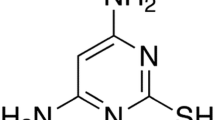Abstract
The corrosion characteristics of amalgamated zinc have been studied in 2.7M NaCl at pH 4.8 using steady-state polarization and a.c. impedance methods, and the influence of various coated paper separators has been determined. It is shown that the polarization behaviour in either the presence or absence of the separator materials can be interpreted if due consideration is given to diffusion and charge transfer effects. The anodic zinc dissolution process is jointly controlled by these effects whereas the cathodic hydrogen evolution (proton reduction) process is diffusion limited.
Using a simple model which takes into account the quasi-reversible nature of the zinc dissolution process, good agreement between calculated and observed current inhibition factors can be obtained if the surface blocking (coverage) effect of the separators is combined with the effect of the change in diffusion path length through the separator pores. Application of this model to the diffusionlimited hydrogen evolution reaction, however, fails unless the blocking term is ignored.
Similar content being viewed by others
Abbreviations
- A e :
-
area fraction of electrolyte in contact with the electrode
- A p :
-
area fraction of polymer in contact with the electrode
- b a :
-
anodic slope of semi-logarithmic current-potential plot
- b c :
-
cathodic slope of semi-logarithmic current-potential plot
- C :
-
surface concentration of zinc species in the absence of the separator
- C s :
-
surface concentration of zinc species in the presence of the separator
- C b :
-
bulk concentration of protons
- C dl :
-
double layer capacity
- D :
-
diffusion coefficient in the absence of the separator
- D s :
-
diffusion coefficient in the presence of the separator
- i :
-
current in the absence of the separator
- i s :
-
current in the presence of the separator
- i ct :
-
charge transfer current
- i d :
-
diffusion current
- i c :
-
cathodic current
- i 0 :
-
exchange current
- i cor :
-
corrosion current
- \(i_{cor}^{R_{de} } \) :
-
corrosion current derived fromR de value
- \(i_{cor}^{R_p } \) :
-
corrosion current derived fromR p value
- i Extcor :
-
corrosion current derived by extrapolation of polarization curves
- i Batcor :
-
corrosion current estimated in complete batteryenvironment
- I cor :
-
corrosion inhibition efficiency (%)
- k f :
-
potential-dependent forward rate constant
- k b :
-
potential-dependent backward rate constant
- l :
-
mean pore length
- r e :
-
resistance of free electrolyte having the same overall volume and geometry as the separator
- r s :
-
resistance of electrolyte within the separator matrix
- R Ω :
-
resistance of electrolyte between Luggin reference probe and electrode surface in the absence of the separator
- R sΩ :
-
resistance of electrolyte between Luggin reference probe and electrode surface in the presence of the separator
- R ct :
-
charge transfer resistance
- R dc :
-
d.c. resistance
- R p :
-
polarization resistance
- l :
-
thickness of the separator
- t p :
-
thickness of the base paper
- t c :
-
thickness of the coating layer
- V e :
-
volume fraction of electrolyte in the separator
- x :
-
distance of Luggin reference probe from electrode surface (absence of separator) or electrolyte exposed outer separator surface (presence of the separator)
- δ:
-
diffusion layer thickness
- θ:
-
tortuosity factor
- 1,2:
-
separator 1,2
- A,B,C:
-
separator A,B,C
References
L. M. Baugh and N. C. White, paper presented at 15th International Power Sources Symposium, Brighton, UK, September, 1986.
L. M. Baugh and N. C. White,J. Appl. Electrochem. 17 (1987) 165.
Idem 17 (1987) 174.
L. M. Baugh, F. L. Tye and N. C. White,13 (1983) 623.
R. D. Armstrong and G. M. Bulman,J. Electroanal. Chem. 25 (1970) 121.
L. M. Baugh and A. R. Baikie,Electrochim. Acta. 30 (1985) 1173.
L. M. Baugh,Electrochim. Acta 24 (1979) 657.
F. L. Tye,Chem. and Ind. May (1982) 322.
B. Poussard, V. Dechenaux, P. Croissant and A. Hardy, in J. Thomson (ed.) Power Sources 7, Academic Press, London, 1979, p. 445.
J. A. Lee, W. C. Maskell and F. L. Tye, in P. Meares, (ed.), Membrane Separation Processes, Elsevier, Amsterdam, Ch. 11, p. 425.
A. Agopsowicz, R. Brett, J. E. A. Shaw and F. L. Tye in D. H. Collins, (ed) Power Sources 5, Academic Press, London, p. 503.
L. M. Baugh and J. A. Lee,J. Electroanal. Chem. 48 (1973) 63.
R. Parsons in Surface Science, Vol. 2, Int. Atom. Energy Agency, Vienna, 1975, p. 144.
L. M. Baugh, F. L. Tye and N. C. White, in J. Thomson (ed.), Power Sources 9, Academic Press, London, 1983, p. 303.
Author information
Authors and Affiliations
Rights and permissions
About this article
Cite this article
Baugh, L.M., White, N.C. Influence of various coated paper separator materials on the corrosion, polarization and impedance characteristics of zinc in concentrated soldium chloride solution. J Appl Electrochem 17, 1281–1295 (1987). https://doi.org/10.1007/BF01023612
Received:
Revised:
Issue Date:
DOI: https://doi.org/10.1007/BF01023612




